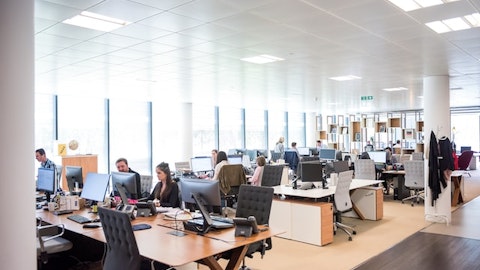Flexsteel Industries, Inc. (NASDAQ:FLXS) Q2 2023 Earnings Call Transcript February 7, 2023
Operator: Good morning, and welcome to the Flexsteel Industries Second Quarter Fiscal Year 2023 Earnings Conference Call. . I would now like to turn the conference over to Alejandro Huerta, Chief Financial Officer for Flexsteel Industries. Please go ahead.
Alejandro Huerta: Thank you, and welcome to today’s call to discuss Flexsteel Industries’ Second Quarter Fiscal Year 2023 financial results. Our earnings release, which we issued after market close yesterday, Monday, February 6, is available on the Investor Relations section of our website at www.flexsteel.com under News and Events. I am here today with Jerry Dittmer, President and Chief Executive Officer; and Derek Schmidt, Chief Operating Officer. On today’s call, we will provide prepared remarks, and then we will open the call to your questions. Before we begin, I would like to remind you that the comments on today’s call will include forward-looking statements, which can be identified using words such as estimate, anticipate, expect and similar phrases.
Forward-looking statements, by their nature, involve estimates, projections, goals, forecasts and assumptions and are subject to risks and uncertainties that could cause actual results or outcomes to differ materially from those expressed in the forward-looking statements. Such risks and uncertainties include, but are not limited to, those that are described in our most recent annual report on Form 10-K as updated by our subsequent quarterly reports on Form 10-Q and other SEC filings as applicable. These forward-looking statements speak only as of the date of this conference call and should not be relied upon as predictions of future events. Additionally, we may refer to non-GAAP measures, which are intended to supplement, but not substitute for the most directly comparable GAAP measures.
The press release available on the website contains the financial and other quantitative information to be discussed today as well as the reconciliation of the GAAP to non-GAAP measures. And with that, I will turn the call over to Jerry Dittmer. Jerry?
Jerald Dittmer: Good morning, and thank you for joining us today. In spite of challenging macroeconomic environment, I am pleased with our performance in the second quarter. I am encouraged by the progress we have made on our strategic initiatives and ability to gain share in the market, allowing us to deliver sales for the quarter of $93.1 million, which was in the range of our guidance as our growth initiatives helped to partially offset the challenges posed by high retail inventories and waning consumer demand. With the softer demand level, we continued to prudently manage spending, deliver on our cost-saving initiatives and offset competitive pricing pressures and inflationary costs to deliver adjusted operating income of $1.0 million.
As discussed in previous quarters, we are committed to driving working capital efficiency and paying down debt, further strengthening our balance sheet. During the second quarter, we were successful in making strides in both as we have improved working capital by $9 million and reduced our outstanding debt by $10.9 million. In the near term, macroeconomic headwinds pose a challenge to industry growth. However, our commitment remains on delivering long-term profitable growth, and we are making pragmatic investments to support these plans. We recently announced a realignment in our organizational structure, reallocating more dedicated resources to new growth pursuits, expanding our sales force, adding sales leadership to gain market share and investing in resources to support the expansion of product management, development and engineering.
As an organization, we are focused on navigating the challenges in the current environment while positioning ourselves to deliver on our long-term strategic initiatives. I’ll now turn the call over to Derek to discuss our strategic initiatives and operational priorities before Alejandro takes you through further details of our financial results. I’ll be back at the end of the call with some closing comments on what we see ahead.
Derek Schmidt: Thank you, Jerry, and good morning, everyone. As Jerry emphasized, we are firmly committed to our strategic growth plans. Given the current economic uncertainty, many furniture manufacturers are responding by scaling back resources and investments, but we’re gearing up for growth. We are managing expenses and cash flow prudently to stay nimble, but we remain on the and are driving investments for future growth. I’d like to expand upon some of the recent growth investments Jerry highlighted earlier. First, we are realigning our leadership structure to accelerate new growth initiatives. Tim Newlin, who is a 25-year veteran of Flexsteel has been named Vice President, Strategic Business Development. In his new role, Tim will leverage his experience and deep knowledge of the furniture industry to accelerate innovation and incubate new ideas that will expand FlexSteel’s business models, brands, products and channels in profitable and fast-growing areas of the market.
David Crimmins expands his responsibilities as Vice President of Sales and Product. David has leadership responsibility for driving our omnichannel strategies in our core business across retail, big box and e-commerce. Additionally, he will strengthen the integration of our product and sales teams to improve our new product speed to market and success rate. Second, we are strengthening resources and investments dedicated to each of our 3 major sales channels. For example, in our retail channel, we recently created a new role of Retail Sales Vice President, who is solely focused on driving continued market share gains in that channel. We are also expanding our retail field sales team by over 10% to promote stronger customer relationships and gain share.
And we’ve committed to implementing a new CRM solution by mid- to late 2023 to improve our customers’ experience. We are making similar investments to support the big box and e-commerce channels as well. Third and lastly, we are investing in our product development and engineering capacity to substantially increase both the number and speed of new product launches in the future. We’re confident these collective structural changes and investments will make us more competitive and help drive profitable growth. Now turning to our specific growth initiatives. Recall that our growth strategy for new business has 3 legs: number one, new sales distribution, 2 new product categories and 3 new consumer segments. We’re making solid progress on all 3 fronts, and the growth potential of these pursuits will accelerate into the second half of the year.
Let me share a few highlights. Beginning with new sales distribution, we’ve made a meaningful entry into big-box distribution this year with a major customer who will become a top 10 and potentially even a top 5 account for us. We are selling a broad set of Flexsteel products to them this year that span all 3 of our major product categories: motion furniture, stationary furniture and case goods and will include launches of our major new products this year, such as Flex, the Charisma brand and some exclusive offerings tailored to this retailer. We also have market tests scheduled in the second half with several other large big-box retailers, which could evolve in the meaningful revenue next fiscal year. Next is new consumer segments. Last quarter, we launched our new brand, Charisma, designed to serve customers, especially younger generations seeking good quality, stylish furniture at affordable popular prices.
Initial retail adoption has been good, and we will extend the sales distribution of Charisma into e-commerce and big box in the second half of the year. Development is already underway to expand the product offering of Charisma, and we expect to show several new smaller stationary frames at the upcoming April High Point market. Last is new product categories. We remain on track for a third quarter launch of Flex, our small parcel contemporary modular furniture solution built to flex with people’s ever-changing lives. Flex has been well received across all channels of our business and will be available for sale this quarter across 4 different distribution platforms, including direct-to-consumer, traditional retail, e-tailers and big box customers.
To protect our innovation, we filed both design and utility patents for this product. The other new product that we’re extremely excited about is decliner, our fleet solutions recliner, which begins shipping to customers in March. Customer feedback has been overwhelmingly positive, and we expect strong and broad sales distribution for this product across both traditional retail and adjacent channels. Development is already in progress to offer additional product enhancements, and we are committed to driving meaningful innovation in the health and wellness category to make decliner a leader in this emerging space. The organization is intensely focused near term on ramping up sales for these growth initiatives, and we’re excited to see the results in the coming quarters.
From an operational viewpoint, we are executing well, maintaining strong service levels and continuing to deliver strong results from our cost savings initiatives. In the near term, these savings are being used to fund price reductions to respond to competitive pressures. While these pressures won’t dissipate completely, we do expect the pricing environment to improve modestly in the second half of the fiscal year since both retailer and manufacturers’ inventories have improved slightly. As a result, we expect more of our cost savings efforts to fall to the bottom line. With that, I’ll turn it over to Alejandro to give you additional details on the financial performance for the second quarter and outlook for the third quarter of fiscal year ’23.
Alejandro Huerta: Thank you, Derek. Good morning, everyone. For the second quarter, net sales were $93.1 million, down approximately $48.6 million or 34.3% compared to $141.7 million in the prior year period. While down from the prior year, our sales results were within our guidance of $87 million to $97 million provided during our first quarter earnings call. From a profit perspective, in the second quarter, the company delivered operating income of $3.8 million or adjusted operating income of $1.0 million or 1.0% of sales, which was within our guidance range of negative 1.5% to positive 1.5% for the quarter. We recorded net income of $2.9 million and earnings per diluted share of $0.53. Adjusted net income for the quarter, which excludes the onetime benefit related to the settlement of the Indiana EPA litigation was $0.4 million, and adjusted income per diluted share was $0.08.
Gross margin as a percent of net sales in the second quarter was 17.0%. The over 1,000 basis point improvement from the prior year quarter was largely driven by effectively reducing ancillary charges, prudently managing costs and navigating competitive pricing pressures. — partially offset by volume decline, deleveraging of fixed costs and continued inflation in domestic transportation charges. Operating income was also supported by a $2.7 million reduction of SG&A expense, mainly through reduced compensation expense and control of other SG&A spending. Moving to the balance sheet and statement of cash flows. The company ended the quarter with a cash balance of $1.8 million and working capital of $107.1 million, which represents a reduction of $9.0 million during the quarter, primarily driven by a $10.6 million decrease in inventory.
The result of the strong working capital management was solid operating cash flow of $11.6 million during the quarter. As previously communicated, debt reduction is a key priority. And in the quarter, we reduced our outstanding borrowings by approximately 36.1% or $10.9 million. Looking forward, guidance for third quarter sales is between $93 million and $103 million. While our strategic growth initiatives will begin to drive meaningful revenue in the second half of the year, the continued macroeconomic challenges will continue to put pressure on our core product offerings. However, we are optimistic that our growth initiatives will help to offset the soft consumer demand and result in quarter-over-quarter growth in the second half of the fiscal year.
Regarding profitability, the impact of our growth initiatives will allow for profit margins to improve sequentially each quarter in the second half of the year. However, competitive pricing pressures, along with continued slumping demand will temper our profitability expansion. We will continue to focus on practical spending levels in line with lower sales levels, but invest in our growth strategies to drive long-term profitability. As such, we are projecting operating income as a percentage of sales in the range of 1.0% to 2.5% for the third quarter. with the largest drivers of variability in the range being consumer demand, competitive pricing conditions and macroeconomic headwinds. We expect gross margins in the range of 16.5% to 18% in the third quarter as our growth initiatives and cost savings initiatives will drive margin expansion.
However, we see this being partially offset by continued pricing pressures in the market due to the compressed demand previously discussed. If sales continue to improve as expected during the remainder of the fiscal year, gross margins should sequentially improve quarter-over-quarter to between the mid- to upper teens. We intend to prudently control SG&A costs and expect SG&A costs between $15 million and $16 million in the third quarter, which is higher than the second quarter as we are actively investing in our growth initiatives discussed by Derek. Regarding our cash flow outlook for the second half of the fiscal year, we expect working capital to be a source of cash, largely driven by a modest reduction in inventory, partially offset by growing account receivable balance due to the higher revenue.
However, the timing of the working capital reduction will be heavily weighted in quarter 4 as we expect working capital to be a modest use of cash in quarter 3 as accounts receivables grow in line with sales, and we deepened our inventory positions of our best-selling fast-moving SKUs. For the third quarter, we expect capital expenditures between $1 million and $1.5 million as we invest in the expansion of our ERP capabilities. We also may continue to opportunistically repurchase shares at a modest spending level if the stock price remains at a significant discount to our view of the intrinsic value. We continue to forecast our debt levels at the end of fiscal 2023 in the range of $4 million to $12 million. The effective tax rate for fiscal 2023 is expected to be in the range of 27% to 28%, excluding the impact of any revaluation of deferred tax asset valuation allowances.
Now I’ll turn the call back over to Jerry to share his perspectives on our outlook.
Jerald Dittmer: Thanks. I’m optimistic about our future, slowing economic growth and weighing consumer demand are obvious challenges for the industry neuter. However, we continue to make prudent investments to ensure our profitable growth and success long term. In the near term , we remain focused on delivering on our strategic initiatives, controlling costs and generating cash flow to pay down debt and preserve liquidity while sensibly investing in growth opportunities. With that, we will open the call to your questions. Operator?
Q&A Session
Follow Flexsteel Industries Inc (NASDAQ:FLXS)
Follow Flexsteel Industries Inc (NASDAQ:FLXS)
Operator: . Our first question will come from Anthony Lebiedzinski of Sidoti and Company.
Anthony Lebiedzinski: Good morning, guys and thank you for taking the question. Yes, you’ve done a very good job of reducing your own inventories. And Derek, you mentioned I believe that inventories overall and the retail level have improved slightly. So what is your sense as to when inventories overall in the retail channel, will get back to so-called normal levels.
Jerald Dittmer: Yes, Anthony, this is Jerry. Good question. So we just completed our West Coast market out in Vegas since we got a chance to talk to several hundred dealers and kind of see what’s going on. And the answer is it’s still pretty choppy. We have several people are ordering. They’re seeing their inventories come down. There’s still a lot of people that have inventory. Their foot traffic is down a little bit, and so the inventories aren’t going down quite as quickly as they had hoped. Is it 3 to 6 months? Is it the rest of the calendar year? — depending on the retailer, that’s really the answer. So again, we’re seeing some that have come down well and others that they said it’s going to take another 6 to 9 months to get it down.
Anthony Lebiedzinski: Got it. Okay. So it sounds like a mixed bag there, okay. But it sounds like also we are past the peak levels as well. So that’s good to hear.
Jerald Dittmer: Correct..
Anthony Lebiedzinski: Do you have any ballpark estimate as to how much of the various growth initiatives you guys talked about? How much did that contribute to the quarter in terms of operating performance?
Jerald Dittmer: Yes, I won’t comment to the quarter, but we have provided guidance in the past and in our current forecast for all of our incremental growth initiatives is between $30 million and $40 million of revenue in the full fiscal year.
Anthony Lebiedzinski: Got it. Yes. And then as far as margins for those initiatives, whether the big box rollout or Charisma or Flex, are the margins for those products comparable to the company average? Or how would you characterize that?
Alejandro Huerta: Anthony, it’s Alejandro. Really good question. We’re driving the growth initiatives to drive accretion in our margin overall.
Anthony Lebiedzinski: Okay. That’s great to hear. And then in terms of the operating margins overall, certainly nice to see pretty good improvement from last year. Back in fiscal ’21, you were at roughly 6.5% operating margin, i certainly realize it’s a much different operating environment now. But it looks like ocean freight costs have come down, labor rates have stabilized. — obviously, you gave guidance for Q3. But then as we look beyond the Q4 going out to fiscal ’24, just I know you haven’t given guidance yet, but just overall, broadly speaking, how should we think about the progression of the operating margin going forward?
Derek Schmidt: Anthony, it’s Derek. So as we look out for the balance of the second half, we are starting to work through some of our higher cost inventories. And so we’ll see margins stabilize and sequentially improved throughout the quarter. We expect a similar trend in fiscal year ’24. So sequential improvement kind of year-over-year. We do plan on investing more behind our growth initiatives. So I stated earlier in the call, we’re adding roles dedicated to our strategic growth initiatives. We’re expanding capacity around new product development. So some of the incremental margin improvement year-over-year will be tempered by higher investments, which we believe will have a phenomenal ROI and will drive long-term profitable growth.
Anthony Lebiedzinski: Got it. Yes. Thanks for the update Derek. And then any update on the Mexicali facility. Where are you guys with that?
Derek Schmidt: Yes. So certainly, in the near term, we do not foresee a need to utilize that, and we’re still evaluating and pursuing opportunities to potentially sublease that in the near term, but still keep it as a long-term option to support our growth.
Anthony Lebiedzinski: Got it. Okay. All right. Well, thank you, the best of luck going forward.
Derek Schmidt: Thanks, Anthony.
Operator: . And our next question will come from JP Geygan of Global Value Investment Corporation.
JP Geygan: It sounds like you had some very interesting developments put, particularly decline are beginning to ship in March and the imminent launch of Flex. You addressed the impact on margins with Anthony, but can you discuss both of those initiatives? And then the expected impact of your strategic growth plans on the overall business, revenue or margins or product penetration, but really more broadly.
Derek Schmidt: Okay. I think as — we look at all of our growth initiatives. Recall that we’ve kind of split them out in these 3 legs, new consumer segments, new sales distribution, new product categories. I think the impact of these growth initiatives on the company longer term will position Flexsteel where the market is going to grow. We’re still certainly dedicated to our traditional retail channel as obvious by the investments that we mentioned earlier. But in 2 to 3 years, a much larger proportion of our sales will come from big box channel and e-commerce. A larger proportion of our sales will come from more modern stylish furniture that is geared towards younger generations. And I think what you’ll find is that we’re pivoting toward differentiated innovation as a competitive advantage as a company.
And I think Flex and decline are good examples of that in the near term. And we’re going to continue to challenge ourselves on how we bring meaningful innovation that’s different than the competitive set because there’s a lot of furniture out there. So I think everything that we got going on near term is really an example of how we’re trying to transform the company for the long term.
JP Geygan: Can you discuss your entry into the big box segment, particularly the impact on margins, both short term and longer term? And then other nuances perhaps like inventory or storage requirements or fulfillment requirements and any challenges you faced thus far?
Derek Schmidt: Yes. I think in terms of big box, the margin profile is better than the current portfolio average. So as Alejandro alluded to, we expect this. We expect all of our growth initiatives to drive margin expansion, kind of long term, big box included. The vast majority of what we’re selling through that channel right now is online. And we are not building inventory necessarily in line in retail stores. I think that will evolve in the future, but it is predominantly an online business. I think challenges. I think there’s — I’ll phrase it differently, JP. There’s been some really good learnings around the expectations that, that channel has that I think long term will actually make us a stronger company. We’re thinking differently around our factory audits, quality programs, fulfillment service, again, that I think it’s going to force us to build capabilities that will serve us well in other areas of the business, which will only lend itself to accelerated growth.
Jerald Dittmer: Yes, JP, this is Jerry. So we have — obviously, we’re used to sending product to a lot of different dealers, a lot of different places all over the country because we have broad distribution — this distribution is the same. And the big box players, there’s 3 to 4 of them that we are in deep trials with right now, and they’re working quite well. Derek’s point of the learnings, there are a lot of learnings there because a lot of this product does not go through our normal distribution networks, things like that. Most of this product is online. Some of it is that we do have trials that are going to be at some big chain stores here coming up. The exciting part here is that the learnings we’re having are going to really help us in our core business also because it’s really helped us balance it. A lot of this is product that we have. We are also in the process of developing new products for these channels also.
JP Geygan: Understood. That’s helpful. How should we expect your capital allocation priorities to change, if at all, as you focus on strategic growth? And in particular, how much debt are you comfortable carrying in your capital structure? And how do you intend to modulate dividends and the share repurchases?
Alejandro Huerta: This is Alejandro. JP. Good question. We’ve talked about this. First and foremost, we’re focused on paying down our debt and with the outlook of somewhere between $4 million and $12 million by the end of fiscal year 2023. That doesn’t mean we’re not opportunistically looking for growth opportunities to invest in, but we’re measuring those against an ROI profile. So first and foremost, pay down debt and then look for strategic opportunities to invest, whether that be equipment, machinery capabilities or even expansion from a production perspective. And then at this time, we’re not thinking about changing our dividend outlook. — for our investors. But obviously, that’s something we discuss with our board on a very regular basis, and we’ll continue to have those discussions. But we want to add the best value possible back to our shareholders.
Jerald Dittmer: JP, just to add to Alejandro’s comments. As we think longer term, again, our intent is to start to build up both cash as well as debt capacity to pursue strategic acquisitions. — long term or, I guess, midterm, we’d be comfortable going up to 3, 3.5x EBIT in terms of debt levels to pursue the right acquisition. But we do want to continue to strengthen the balance sheet so that we can pursue those opportunities if the right one comes along.
Alejandro Huerta: The other question you had, JP, was in regards to our share repurchase. We will continue to look at that and be opportunistic if our stock stays at a level that we feel it’s a very good investment for our shareholders. We will continue to do that.
JP Geygan: Okay. And then one final point of clarification. Derek, you alluded to an ROI expectation on your strategic growth initiatives before. Can you put any sort of color around that?
Derek Schmidt: Yes. I mean the only color I’ll give JP, is — we look at all of our investments relative to our cost of capital. And we have confidence that how we’re deploying capital is going to generate shareholder value creation. So again, I won’t give you specific ROI numbers, but rest assured that we’ve got confidence that these things are value added.
JP Geygan: Okay appreciate your time and thanks for taking my questions and congratulations on a nice quarter.
Derek Schmidt: Thanks, JP.
Operator: The next question comes from John Deysher of Pinnacle.
John Deysher: Just to confirm, the product that’s going into the big box retailers, that’s your brand, correct? You’re not doing any type of private labeling…
Derek Schmidt: We’re actually doing some of both. So we do have — actually, they are sometimes using their own brands. They are sometimes using our brands and sometimes we are off of just coming out with some new labels that we may also use going forward.
Jerald Dittmer: Currently though, John, the vast majority of what is flowing through big box today is Flexsteel branded, but we are exploring some other white label options for, what I’ll call, lower cost product.
John Deysher: Okay. White Label is private label?
Derek Schmidt: Correct
John Deysher: Okay. All right. So you’ll be able to discuss that more as you get through the process of testing and all of that, correct?
Derek Schmidt: Yes. Correct.
John Deysher: Okay. Fair enough. The other question is, what was the backlog at the end of the quarter?
Derek Schmidt: Roughly $60 million. It’s been, I think, since the beginning of the year, kind of floating between $55 million and $60 million. So it’s stabilized and back to normal levels.
John Deysher: Okay. Very good. Thanks, and good luck.
Derek Schmidt: Thank you.
Jerald Dittmer: Thank you
Operator: This concludes our question-and-answer session. I would like to turn the conference back over to Jerry Dittmer for any closing remarks.
Jerald Dittmer: Thank you. In closing, I would again like to thank all our Flexsteel employees for their outstanding performance and service during the second quarter. We are really excited about our future and what everyone is bringing with us. I would also like to thank you for participating in today’s call. Thank you for those that ask questions. And please reach out any additional ones. We look forward to updating you on our next call. Thanks, everybody. Have a great day.
Operator: The conference has now concluded. Thank you for attending today’s presentation, and you may now disconnect.





